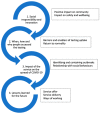A Qualitative Evaluation of the Barriers and Enablers for Implementation of an Asymptomatic SARS-CoV-2 Testing Service at the University of Nottingham: A Multi-Site Higher Education Setting in England
- PMID: 36293719
- PMCID: PMC9603241
- DOI: 10.3390/ijerph192013140
A Qualitative Evaluation of the Barriers and Enablers for Implementation of an Asymptomatic SARS-CoV-2 Testing Service at the University of Nottingham: A Multi-Site Higher Education Setting in England
Abstract
Asymptomatic testing for SARS-CoV-2 RNA has been used to prevent and manage COVID-19 outbreaks in university settings, but few studies have explored their implementation. The aim of the study was to evaluate how an accredited asymptomatic SARS-CoV-2 testing service (ATS) was implemented at the University of Nottingham, a multi-campus university in England, to identify barriers and enablers of implementation and to draw out lessons for implementing pandemic response initiatives in higher education settings. A qualitative interview study was conducted with 25 ATS personnel between May and July 2022. Interviews were conducted online, audio-recorded, and transcribed. Participants were asked about their experience of the ATS, barriers and enablers of implementation. Transcripts were thematically analysed. There were four overarching themes: (1) social responsibility and innovation, (2) when, how and why people accessed testing, (3) impact of the ATS on the spread of COVID-19, and (4) lessons learned for the future. In establishing the service, the institution was seen to be valuing its community and socially responsible. The service was viewed to be broadly successful as a COVID-19 mitigation approach. Challenges to service implementation were the rapidly changing pandemic situation and government advice, delays in service accreditation and rollout to staff, ambivalence towards testing and isolating in the target population, and an inability to provide follow-up support for positive cases within the service. Facilitators included service visibility, reduction in organisational bureaucracy and red tape, inclusive leadership, collaborative working with regular feedback on service status, flexibility in service delivery approaches and simplicity of saliva testing. The ATS instilled a perception of early 'return to normality' and impacted positively on staff feelings of safety and wellbeing, with wider benefits for healthcare services and local communities. In conclusion, we identified common themes that have facilitated or hindered the implementation of a SARS-CoV-2 testing service at a university in England. Lessons learned from ATS implementation will inform future pandemic response interventions in higher education settings.
Trial registration: ClinicalTrials.gov NCT05045989.
Keywords: COVID-19; SARS-CoV-2; health protection; health testing; pandemic; qualitative.
Conflict of interest statement
CD is Academic lead and co-founder of the ATS. JKB is co-founder of, and virology advisor to the ATS. HB is behavioural advisor to the ATS. No other conflicts of interest are declared.
Figures




Similar articles
-
Mixed-methods process evaluation of a residence-based SARS-CoV-2 testing participation pilot on a UK university campus during the COVID-19 pandemic.BMC Public Health. 2022 Aug 2;22(1):1470. doi: 10.1186/s12889-022-13792-8. BMC Public Health. 2022. PMID: 35915479 Free PMC article.
-
Workforce Experiences of a Rapidly Established SARS-CoV-2 Asymptomatic Testing Service in a Higher Education Setting: A Qualitative Study.Int J Environ Res Public Health. 2022 Sep 30;19(19):12464. doi: 10.3390/ijerph191912464. Int J Environ Res Public Health. 2022. PMID: 36231764 Free PMC article.
-
Students' Views towards Sars-Cov-2 Mass Asymptomatic Testing, Social Distancing and Self-Isolation in a University Setting during the COVID-19 Pandemic: A Qualitative Study.Int J Environ Res Public Health. 2021 Apr 15;18(8):4182. doi: 10.3390/ijerph18084182. Int J Environ Res Public Health. 2021. PMID: 33920908 Free PMC article.
-
Service design for children and young people with common mental health problems: literature review, service mapping and collective case study.Health Soc Care Deliv Res. 2024 May;12(13):1-181. doi: 10.3310/DKRT6293. Health Soc Care Deliv Res. 2024. PMID: 38767587 Review.
-
Youth violence intervention programme for vulnerable young people attending emergency departments in London: a rapid evaluation.Health Soc Care Deliv Res. 2023 Jul;11(10):1-122. doi: 10.3310/JWKT0492. Health Soc Care Deliv Res. 2023. PMID: 37470144
Cited by
-
From disgusting and complicated to simple and brilliant: Implementation perspectives and lessons learned from users and rejectors of mail-in SARS-CoV-2 gargle tests.Front Public Health. 2023 Jan 5;10:1024525. doi: 10.3389/fpubh.2022.1024525. eCollection 2022. Front Public Health. 2023. PMID: 36684995 Free PMC article.
-
Assessment of COVID-19 Messaging Strategies to Increase Testing for Students With Intellectual and Developmental Disabilities.J Sch Health. 2024 Jun;94(6):551-561. doi: 10.1111/josh.13448. Epub 2024 Mar 29. J Sch Health. 2024. PMID: 38551064 Free PMC article. Clinical Trial.
References
-
- Knight H., Carlisle S., O’Connor M., Briggs L., Fothergill L., Al-Oraibi A., Yildirim M., Morling J.R., Corner J., Ball J. Impacts of the COVID-19 pandemic and Self-Isolation on students and staff in higher education: A qualitative study. Int. J. Environ. Res. Public Health. 2021;18:10675. doi: 10.3390/ijerph182010675. - DOI - PMC - PubMed
-
- Blake H., Knight H., Jia R., Corner J., Morling J.R., Denning C., Ball J.K., Bolton K., Figueredo G., Morris D.E. Students’ views towards SARS-CoV-2 mass asymptomatic testing, social distancing and self-isolation in a university setting during the COVID-19 pandemic: A qualitative study. Int. J. Environ. Res. Public Health. 2021;18:4182. doi: 10.3390/ijerph18084182. - DOI - PMC - PubMed
-
- Leal Filho W., Wall T., Rayman-Bacchus L., Mifsud M., Pritchard D.J., Lovren V.O., Farinha C., Petrovic D.S., Balogun A.-L. Impacts of COVID-19 and social isolation on academic staff and students at universities: A cross-sectional study. BMC Public Health. 2021;21:1213. doi: 10.1186/s12889-021-11040-z. - DOI - PMC - PubMed
Publication types
MeSH terms
Substances
Associated data
LinkOut - more resources
Full Text Sources
Medical
Miscellaneous

